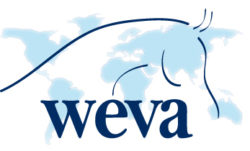Coordinator and reporter Jennifer Zhou
The 2021 WEVA-China Advanced Equine Lameness Free Online Webinar was successfully jointly hosted on the 2nd of June by CHIA (previous partner of 15th WEVA congress in Beijing) and online education platform supplier DuoYue Veterinary Education. The speakers were two of the most well-known and respected professors on equine lameness, Prof. Roger Smith and Prof. Michael Schramme, who are both well recognized by Chinese veterinary colleagues. Due to the Covid19 pandemic, this is the first equine medicine training offered by foreign speakers and one of only a few equine trainings in China since 2019. Veterinary colleagues were quite excited and looking forward to the webinar. The poster was shared in most Chinese equine veterinary/equestrian sport WeChat groups and some equine lameness/veterinary Facebook groups. On the training day, there were on average 90 online attendees. 40% were Chinese locals and rest were from 22 other countries, such as Thailand (14%), Korea (7%), Pakistan, United States, Latvia, Belgium and Romania.
The schedule was as below:
| Welcome and introduction | Dr. Chris Riggs/ CHIA/ DUOYUE |
| Clinical examination of foot lameness | Prof. Roger Smith |
| How to perform and interpret diagnostic anesthesia of the lower limb | Prof. Michael Schramme |
| Tea break | |
| Radiography and radiology of the foot | Prof. Roger Smith |
| Diagnosis and management of osseous abnormalities of the fetlock joint in athletic horses | Prof. Michael Schramme |
| Meal break | |
| Diagnosis and management of traumatic arthritis of the distal interphalangeal joint and bone contusions of the phalanges | Prof. Roger Smith |
| Diagnosis of back and sacroiliac pain | Prof. Michael Schramme |
| Tea Break | |
| The suspensory apparatus (including the suspensory ligament and distal sesamoidean ligaments) | Prof. Roger Smith |
| Management of thoracolumbar and sacro-iliac joint pain | Prof. Michael Schramme |
| Q&A, conclusion and thanks | Dr. Jennifer Zhou |
We issued a questionnaire to the attendees after the webinar which showed:
The majority of attendees were veterinarians who mostly work with equine, while a small number were horse owners or veterinarian students. Attendees were very content with the online platform training and happy that they could watch a translated replay afterwards. They thought the length of webinar was either optimum or could perhaps even be longer. They said content of the webinar was very practical and could be very helpful for their hands-on practice. The most popular lectures, in order of popularity were:
1, Diagnosis of back and sacroiliac pain by Prof. Michael Schramme
2, Clinical examination of foot lameness By Prof. Roger Smith
3, Management of thoracolumbar and sacro-iliac joint pain by Prof. Michael Schramme
4, Radiography and radiology of the foot Prof. By Roger Smith
5, The suspensory apparatus (including the suspensory ligament and distal sesamoidean ligaments) by Prof. Roger Smith
We also collected suggestions from attendees of topics that they would like to hear in future lectures. These included: respiratory diseases; radiology; colic; neurology; laminitis; pain recognition and management; osteoarthritis.
Some comments from attendees:
“This was a very practical training and I hope we could have more of this kind of training in the future.”
“The content was informative and detailed. I hope there will be more and more lectures like this.”
“Lameness diagnosis, especially image diagnosis, is very useful for my work. The only problem is my English understanding is not good enough to follow most of the lectures in real time. I hope in the future there will be simultaneous translation.”
“The webinar schedule was designed really well for clinicians working in China.”
How we could improve:
1, Gathering information of both international and domestic audience to keep them up to date with any trainings in the future, or in correspondence of any questions from the webinar or training. At the moment, WEVA has a very active WeChat group to connect Chinese colleagues and this is a great way to be able to respond promptly to any of their enquiries. I believe WEVA needs a Facebook group (unfortunately Facebook is blocked in China). The group can be used for posting training information and collecting contact information of attendees, and later on issuing training certificates once their email is kept.
2, CHIA stamped training certificates are currently offered by DuoYue Education. If we have a routine or set program such as equine lameness or other fields, we could apply in advance to CVMA (Chinese Veterinary Medicine Association) for CE credit. There were foreign attendees of this webinar who asked for training certificates. I wonder if we could have our speakers’ signature on such certificates?
3, Adding translations on replays is a huge effort. We currently have 2 volunteers working on it and progress is very slow. Attendees asked for simultaneous translation and that would be better, but it is difficult to find professional people to do it.
4, To provide attendees with a replay and handout, we are using two different platforms due to the influence of the Chinese internet monitoring system. Inside China we are using my personal Baidu account and outside of China we are currently using WeTransfer. As we don’t have a WeTransfer membership, materials shared on their platform will expire after two weeks.
The replay link is : https://we.tl/t-eza5yfkWuW


